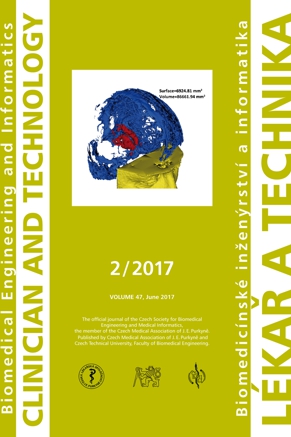EXPERIMENTAL ANALYSIS OF THE LUMBAR SPINE KINEMATICS
Keywords:
low back pain, kinematics, intervertebral joint, instantaneous centre of rotation (ICR), artificial discAbstract
Pain-provoking disorders of the lumbar spine affect most of adult population and nearly everyone suffers from some of them during their lifetime. A common symptom of diseases, injuries or inevitable changes in the area of lumbar spine is known as the Low Back Pain (LBP). A chronic form of the LBP, called the Low Back Pain syndrome, is mostly caused by degenerative changes of intervertebral discs of the lowest intervertebral joints. The work was focused on in vitro analysis of the porcine lumbar spine kinematics. Two last neighbouring intervertebral joints without active tissue, L4/5 and L5/6, were used. The total number of fifteen cadaveric samples of porcine lumbar spine was involved. A unique loading mechanism was designed and constructed for the purposes of this study. Samples were loaded by flexion/extension movement within the physiological range of motion of ± 5°, in a quasi-static mode. The recording and analysing of the lumbar spine kinematics was realized by the motion capture camera system (Qualisys AB, Göteborg, Sweden). The results showed that the so-called instantaneous axis of rotation (IAR), or the corresponding instantaneous centre of rotation (ICR), was an adequate objective parameter for the assessment of the lumbar spine kinematics. Its position was comparable across all samples and situated very close to the spinal canal. For the purposes of this work, an altered artificial disc of a ball-and-socket type (ProSpon, Ltd., Kladno, Czech Republic) was used to study the kinematics of two neighbouring joints after the disc replacement in the area of a caudally situated one. The results of this comparative analysis showed a significant influence of the artificial disc on the kinematics of both, caudally situated joint, where the disc was implanted, and the adjacent one.Downloads
Published
Issue
Section
License
Copyright (c) 2017 Lubos Tomsovsky, Petr Kubovy, Martin Otahal

This work is licensed under a Creative Commons Attribution 4.0 International License.
Authors who publish with this journal agree to the following terms:
- Authors retain copyright and grant the journal right of the first publication with the work simultaneously licensed under a Creative Commons Attribution License (https://creativecommons.org/licenses/by/4.0/) that allows others to share the work with an acknowledgment of the work's authorship and initial publication in CTJ.
- Authors are able to enter into separate, additional contractual arrangements for the non-exclusive distribution of the journal’s published version of the work (e.g., post it to an institutional repository or publish it in a book), with an acknowledgment of its initial publication in this journal.
- Authors are permitted and encouraged to post their work online (e.g., in institutional repositories or on their website or ResearchGate) prior to and during the submission process, as it can lead to productive exchanges.
CTJ requires that all of the content of the manuscript has been created by its respective authors or that permission to use a copyrighted material has been obtained by the authors before submitting the manuscript to CTJ. CTJ requires that authors have not used any copyrighted material illegally, as for example a picture from another journal or book, a photo, etc. It is the author’s responsibility to use only materials not violating the copyright law. When in doubt, CTJ may ask the authors to supply the pertinent permission or agreement about the use of a copyrighted material.
The opinions expressed in CTJ articles are those of authors and do not necessarily reflect the views of the publishers or the Czech Society for Biomedical Engineering and Medical Informatics.


